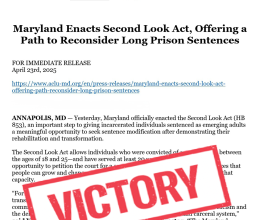
An Empirical Analysis Of Maryland’s Death Sentencing System With Respect To The Influence Of Race And Legal Jurisdiction: Final Report
There have been suggestions in the past that the imposition of the death penalty in Maryland has been influenced by factors such as race and the particular legal jurisdiction where the homicide occurred. Critics have pointed to the racial composition of Maryland’s death row as evidence that there is racial disparity in the operation of the death penalty in the state. For example, in December of 2002 all thirteen men on Maryland’s death row were sentenced to death for killing whites and in eight of these thirteen (62%) the offender was black.1 In fact, since 1978, when the state’s new death penalty statute took effect, there have been no fewer than four investigations into the administration of the death penalty in Maryland, with at least some emphasis on the issues of racial disparity and arbitrariness (geographic disparity).
In this report, we will first provide a brief description of the recent history of capital punishment in the state of Maryland, including concerns about the fairness with which it has been imposed in the past. We will then briefly describe the legal structure or mechanics of the death penalty under Maryland law. We will then briefly discuss the methodology we followed in this empirical study of the death penalty in Maryland, with particular attention devoted to describing how we characterized an offense as “death eligible”, and the statistical strategy we followed in determining the influence of race and geography on the four decision making points. This will be followed by a detailed presentation of our results – what we found with respect to the administration of the death penalty. In the final section of the report we summarize these findings.
Related content

Advocates Celebrate Passage of Second Look Act, Urge Continued Push...
April 9, 2025ACLU of Maryland and Advocates Urge Senate to Pass the Second Look...
March 19, 2025
A Second Look at Extreme Sentences Saves Lives and Strengthens...
March 13, 2025
Maryland Needs A Second Look Act

John & Autumn Woodland – Family Reunification (Life After A Second...
November 26, 2024
Free State Liberties - Winter 2025
November 25, 2024
ACLU of Maryland's Advocacy in the 2025 General Assembly
November 25, 2024